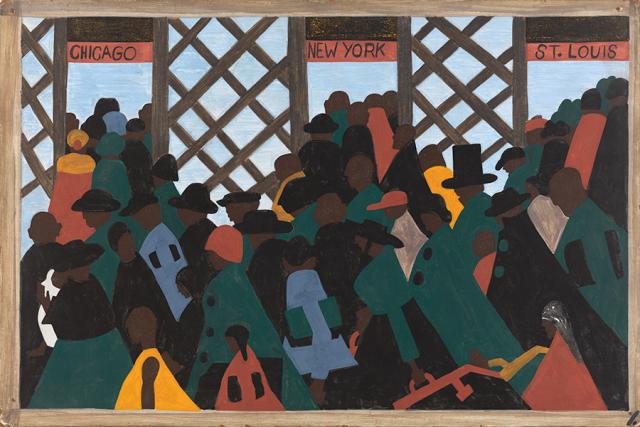Jacob Lawrence's Migration Series at The Phillips Collection

The Phillips Collection is hosting an exhibition, People on the Move: Beauty and Struggle in Jacob Lawrence's Migration Series through January 7, 2017. All 60 panels of The Migration Series are included, reuniting the Phillips’s odd-numbered panels with the Museum of Modern Art’s even-numbered panels from their split acquisition in 1942.
More than 75 years ago, a young artist named Jacob Lawrence (1917–2000) set to work on an ambitious 60-panel series portraying the Great Migration, the movement between the World Wars of over a million African Americans from the rural South to the industrial North in search of a better life. The mass exodus prompted by wartime shortages and oppressive conditions for blacks in the South, was the largest population shift of African Americans since the time of slavery. Lawrence had spent the past three years addressing similar themes of struggle, triumph, and adversity in his narrative portraits on the lives of Harriet Tubman, leader of the Underground Railroad (1940), Frederick Douglass, abolitionist (1939), and Toussaint L’Ouverture, liberator of Haiti (1938).
Born in Atlantic City to parents who had made the migration North from Virginia and South Carolina, Lawrence spent his childhood in Philadelphia and Harlem among a continually expanding community of southern migrants. As a teenager, Lawrence exhibited artistic promise attending the Harlem Art Workshop and became immersed in Harlem’s vibrant cultural life. Through such mentors as artist Charles Alston, sculptor Augusta Savage, poet Claude McKay, and philosopher Alain Locke, Lawrence was exposed to the latest currents in modern art, finding sympathy with the work of the German Expressionists, social realists, and Mexican muralists. In 1940, Lawrence conceived of the idea to create The Migration of the Negro (now known as The Migration Series). With support from a Julius Rosenwald Fund fellowship, the young artist was able to rent a studio at 33 West 125th Street. There, in just under a year, with the assistance of his future wife, artist Gwendolyn Knight, Lawrence realized his 60-panel epic, the largest series of his career.
In telling the story of the Great Migration, Lawrence drew not only upon primary accounts he consulted at the New York Public Library, but also on the oral histories passed on to him from the Harlem community, from the street orators and preachers to the librarians, teachers, and Apollo Theater actors. Lawrence heard their stories, observed their struggles, and witnessed firsthand the realities of life in the “Promised Land.” In his Migration Series, Lawrence reminds us of our shared history and at the same time invites us to reflect on our contemporary world: “To me, migration means movement. There was conflict and struggle. But out of the struggle came a kind of power and even beauty. ‘And the migrants kept coming’ is a refrain of triumph over adversity. If it rings true for you today, then it must still strike a chord in our American experience.”
